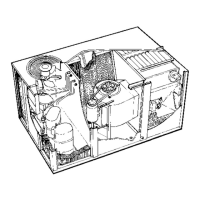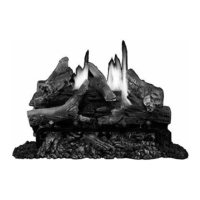Page 71
C1 DIAGRAM WITH B9 and A8 DIAGRAMS
Electromechanical Thermostat Connected to GCS16-1853 with 235,000 or 330,000 BTUH Input Heat (Without Economizer)
D-GCS16-1853
Operation Sequence: C1 and B9 and A8 Sections (electromechanical thermostat wired to
GCS16-1853)
The GCS161853 and CHA161853 are the only units in the Lennox 16series product line which
feature three compressors and three independent cooling circuits. Two compressors operate dur
ing first stage demand separated by a time delay. The third compressor only operates during sec
ond stage cooling demand.
The GCS161853 and CHA161853 are also the smallest units in the 16series lineup to come
factory equipped with a pilot relay board. The board is used to reduce contactor chattering caused
by long runs of undersized thermostat wire. The relays on the pilot relay board have a compara
tively smaller inrush than the contactors they serve thereby reducing the potential for contactor
chattering.
Finally, all 1853 and larger units are designed with a modular" heating section which may be easi
ly changed in the factory to larger or smaller BTUH input sizes. Each different heat section is repre
sented by a unique heating section wiring diagram which mates to the unit diagram as shown on
the facing page (diagram A8). In the GCS161853, both BTUH input size use the same wiring
diagram. And, the same heating diagram is used in larger GCS16 units. Look for the (A8) diagram
on the following pages.
In the 1853, both condenser fans operate during first stage cooling operation.
Power:
1- When the unit disconnect closes, line voltage energizes transformer T1 and the com
pressor crankcase heaters. Transformer T1 provides 24VAC power to unit cooling,
heating and blower controls and thermostat. The crankcase heaters are powered at
all times but are selfregulating
2- Transformer T3 (460V and 575V units) is also energized when power is applied to the
unit.
3- Transformer T10 (units equipped with power exhaust fans) is also energized when
power is applied to the unit.
Cooling Demand:
4- On a call for first stage cooling (Y1), pilot relay K66 is energized after DL8 completes a 30 sec
ond on delay.
5- At the same time, the indoor thermostat energizes the indoor blower circuit (G). Blower demand
energizes pilot relay K46.
6- When K661 closes, a 24VAC circuit is completed through the first stage safety limits
to energize contactor K1. Contactor K1 immediately switches. At the same time,
K661 also energizes condenser fan contactor K10 and time delay DL15. DL15 be
gins timing sequence.
7- When K461 closes, a 24VAC circuit is completed through blower relays K20 and K25 to ener
gize indoor blower contactor K3. K3 immediately switches.
8- When contacts K31 close, the indoor blower is energized immediately and begins oper
ating. When K32 closes, a circuit is completed to the optional economizer to open the
outdoor air dampers to minimum position.
9- When contacts K101 close, condenser fans B4 and B5 are both energized and immediately
begin operating.
10- When contacts K1-1 close, comrpressor B1 is energized and immediately begins op
erating.
11- When time delay DL15 has elapsed, a first stage demand is passed through the second com
pressor safety circuits to energize compressor contactor K2. K2 immediately switches.
12- When K21 closes, comrpressor B2 is energized and immediately begins operating.
13- On a call for increased cooling (Y2), pilot relay K67 is energized after DL9 completes a 30 sec
ond on delay.
14- When K671 closes, a 24VAC circuit is completed through the second stage safety limits to en
ergize contactor K14. K14 immediately switches.
15- When contacts K141 close, compressor B13 is energized and immediately begins op
erating.
Heating Demand:
16- On a call for first stage heating (W1), pilot relay K77 is energized.
17- When K771 closes, a 24VAC circuit is completed into the heating section to energize combus
tion air blower relay K13.
18- When contacts K131 close, combustion air blower B6 is energized and immediately begins
operating. When contactst K132 close, the gas valve is enabled.
19- As the combustion air blower approaches full speed, combustion air blower prove switch (S18)
closes.
20- When S18 closes a 24VAC circuit is completed through the heating safety switches to energize
burner ignition control A3.
21- When ignition control A3 determines that ignition can begin, A3 simultaneously sends 24VAC to
the first stage operator of the gas valve and to the indoor blower delay relay (K25) and also
sends spark to the spark electrode. The gas valve immediately opens and blower delay K25
immediately begins timing.
22- When flame is sensed by the ignition control, spark is stopped and the gas valve re
mains open. If flame is not sensed within the time allowed, spark is stopped, the gas
valve is closed and the ignition control begins its retrial timing sequence.
23- When blower delay K25 ends its timing period, K251 switches. A 24VAC circuit is
completed through K201 to energize blower contactor K3.
24- When contacts K31 close, the indoor blower is energized immediately begins operat
ing. When K32 closes, a circuit is completed to the optional economizer to open the
outdoor air dampers to minimum position.
25- On a call for increased heating (W2), pilot relay K49 is energized.
26- When K491 closes, a 24VAC circuit is completed into the heating compartment to en
ergize time delay DL3. DL3 immediately begins its timing sequence.
27- When DL3 time delay has elapsed, DL3 closes internally to complete a circuit to energize the
second stage heat pilot relay K19.
28- When K191 closes, a 24VAC circuit is completed to the second stage operator of the gas valve
(W2). When gas valve operator W2 is energized, the gas valve begins to slowly open for second
stage operation.
29- If either heating limit S10 or S21 open during heating operation, ignition control A3 is immediately
deenergized and blower limit relay K20 is immediately energized.
30- When A3 is deenergized, the gas valve (W1) and blower delay (K25) are both deen
ergized.
31- When K201 switches, blower contactor K3 is energized to continue blower operation during the
time that safety limits are open.
32- When gas valve (W1) is deenergized, it prevents second stage gas valve (W2) from
operating.

